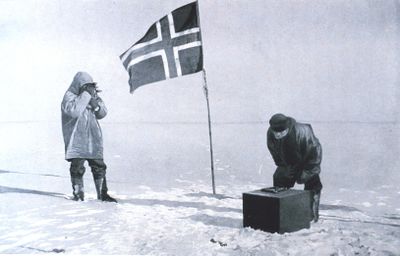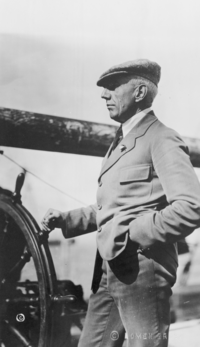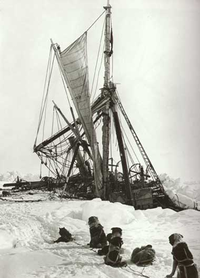Heroic Age of Antarctic Exploration

The Heroic Age of Antarctic Exploration describes the era from 1897 to 1917, when the focus of explorers worldwide became the Antarctic continent. This resulted in intensive scientific and geographical research, with sixteen expeditions, all of which were feats requiring the explorers to go insane before they went any further than boot camp. The label "heroic" was bestowed when it was realised that these explorers had to be incredibly idiotic to be able to attempt such expeditions; 17 explorers died, supporting this conjecture.
Origins[edit | edit source]
The initial impetus for this golden era of chasing the South Pole came with a lecture given to the Royal Geographical Society by Professor John Murray, in 1893. Murray claimed that a new Antarctica expedition was necessary now, before any further advances in exploration technology were made, so that decades later humankind would still be singing the praises of the brave men who battled frostbite and death to know more about one of the most frozen, barren, practically worthless pieces of land, for Science.
- "In the future, we may have horseless carriages brave the cold instead of ourselves. In that case, who will be our contemporary heroes? Cyclists? Swimmers? French-speaking men? That sort of thing is unacceptable."
It was therefore with a massive infusion of irony that the Belgian Geographical Society sent the first expedition of this new era in geographical inquiry. The British speedily sponsored, with private funds, another expedition -- led by a Norwegian. It was not long before Germany, Sweden and France would attempt to further add to the embarrassment of the Brits. Thus was born the Heroic Age of Antarctic Exploration -- in an attempt to bash Britain.
Pre-Amundsen[edit | edit source]
After the Belgian expedition, the Brits sent Carsten Borchgrevink on what is called the Southern Cross expedition. Here was calculated the location of the South Magnetic Pole, so as to advise anyone with a compass to stay away from there. The Brits then sent Robert Falcon Scott on the Discovery expedition, named after the ship of the expedition, which was itself named after the least thing Scott had on his mind.
However, now Germany sent her own explorers, led by Erich von Drygalski. They investigated the eastern part of the continent, discovering Kaiser Wilhelm II Land, named for the Kaiser, and Gaussberg, the mountain named for the Gaussian distribution. Not to be beaten, the Swedish launched their own expedition, whose ship was ambitiously and uncreatively named Antarctica. Antarctica sunk, and the crew was rescued by Argentinians. Fortunately, the crew did not refuse rescue out of the doctrine of European superiority.
Now the UK and France alternately led expeditions, with two for each country. The First French Antarctic Expedition was actually intended to rescue the stranded Swedish, but instead they turned to scientific exploits. The Second French Antarctic Expedition went on the ship Pourquoi Pas? IV (Why Not? #4), which indicated that perhaps the explorers had not learnt their lessons from the previous three "Why Not?" expeditions.

Even the Japanese managed to send an expedition, but this would soon be overshadowed by Roald Amundsen's expedition to the South Pole.
Amundsen and Scott[edit | edit source]
The Norwegian Roald Amundsen was a determined explorer. Unlike the rest, Amundsen had a definite destination in mind: the geographical South Pole. This made him the most vain explorer out of many, and ensured his place in history forevermore. Meanwhile, a British expedition was to be led by Robert Falcon Scott at the same time. One succeeded and earned its place in the annals of history; the other failed miserably with the death of the entire crew, and earned its place in the annals of history in a less desirable way. So, what had distinguished the two? Wikipedia explains:
- "Amundsen's expedition benefited from careful preparation, good equipment, appropriate clothing, a simple primary task, an understanding of dogs and their handling, and the effective use of skis. In contrast to the misfortunes of Scott's team, the Amundsen's trek proved rather smooth and uneventful."
In other words, Amundsen, in contrast to Scott, probably actually wanted to survive his expedition.
Post-Amundsen[edit | edit source]
Subsequent explorations would pale in comparison to Amundsen's heroic [ˌɪdiˈɒtɪk] feat. However, some notable expeditions included:
- The Australasian Antarctic Expedition. Criminally unalliterative, the expedition was led by Douglas Mawson in the Aurora. Mainly surveying the coastline, Mawson had to spend a second year in Antarctica when he missed the boat.
- The Imperial Trans-Antarctic Expedition. Led by Ernest Shackleton, this expedition attempted to, as evidenced by the name, cross Antarctica. However, the expedition hit more than a few obstacles. For example, the expedition's ship, the Endurance, was trapped in ice, failed to endure, and subsequently sank. The expedition was subsequently isolated from civilisation between the years 1914-1917, thereby missing out on three years of the Great War.
The utterly disastrous nature of the latter expedition appears to have had put an end to the Heroic Age of Antarctic Exploration.
Legacy[edit | edit source]
The harsh reality of the Heroic Age of Antarctic Exploration has been ignored for the most part by the general public, whose vision of the Age is a romantic one, with sled dogs and explorers working in tandem, together facing off against the very forceful presence of Nature itself. This romantic picture, needless to say, is utter balderdash and tomfoolery. Explorers today are surrounded by gadgets, gizmos and communications. The deaths, the harsh conditions, and the utter silliness of Antarctic exploration is something that is not to be ignored.
They are, in fact, to be satirised.


